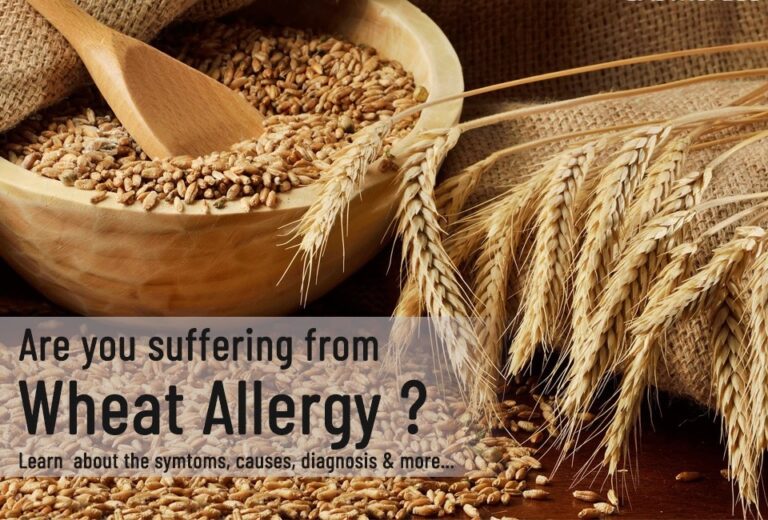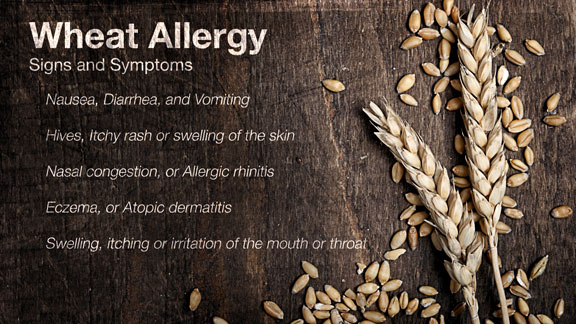WHEAT ALLERGY – SYMPTOMS, CAUSES, AND TREATMENT
Wheat allergy is an allergic reaction to foods consisting of wheat. Allergic reactions could be caused by eating wheat and also, in some cases, by inhaling wheat flour.
Avoiding wheat is the main treatment for wheat allergy, but that is not always as easy as it sounds. Wheat is found in many foods, including some you may not suspect, like soy sauce, ice cream, and hot dogs. Medications might be necessary to manage allergic reactions if you accidentally eat wheat.

Wheat allergy sometimes is confused with celiac disease, but these conditions vary. A wheat allergy happens when your body produces antibodies to proteins found in wheat. In celiac disease, a certain protein in wheat — gluten — causes a different type of abnormal immune system reaction.
SYMPTOMS
A child or adult with wheat allergy is likely to develop signs and symptoms within minutes to hours after eating something consisting of wheat. Wheat allergy signs and symptoms are:
- Swelling, itching, or irritation of the mouth or throat
- Hives, itchy rash, or swelling of the skin
- Nasal congestion
- Headache
- Trouble breathing
- Cramps, nausea, or vomiting
- Diarrhea
- Anaphylaxis

Anaphylaxis
For some people, wheat allergy might cause a life-threatening reaction known as anaphylaxis. In addition to other signs and symptoms of wheat allergy, anaphylaxis might cause:
- Swelling or tightness of the throat
- Chest pain or tightness
- Severe difficulty breathing
- Difficulty swallowing
- Pale, blue skin color
- Dizziness or fainting
WHEN SHOULD YOU SEE A DOCTOR?
If someone shows signs of anaphylaxis, call 911 immediately or your local emergency number. Anaphylaxis is a medical emergency that needs prompt care.
If you suspect that you or your child is allergic to wheat or another food, consult your doctor.
CAUSES
If you have a wheat allergy, exposure to a wheat protein prepares your immune system for an allergic reaction. You could develop an allergy to any of the four classes of wheat proteins — albumin, globulin, gliadin, and gluten.
Sources of wheat proteins
Some sources of wheat proteins are obvious, like bread, but all wheat proteins — and gluten in particular — could be found in many prepared foods and even in some cosmetics, bath products, and play dough. Foods that might include wheat proteins include:
- Bread and bread crumbs
- Cakes, muffins, and cookies
- Breakfast cereals
- Pasta
- Couscous
- Farina
- Semolina
- Spelt
- Crackers
- Hydrolyzed vegetable protein
- Soy sauce
- Meat products, like hot dogs
- Dairy products, like ice cream
- Natural flavorings
- Gelatinized starch
- Modified food starch
- Vegetable gum
If you have a wheat allergy, it is possible you may also be allergic to barley, oats, and rye. Unless you are allergic to grains other than wheat, though, the recommended wheat-free diet is less restrictive than a gluten-free diet.
Wheat-dependent, exercise-induced anaphylaxis
Some people with wheat allergy develop symptoms only if they exercise within a few hours after consuming wheat. Exercise-induced changes in your body either trigger an allergic reaction or aggravate the immune system response to a wheat protein. This condition generally results in life-threatening anaphylaxis.

RISK FACTORS
Certain factors might put you at greater risk of developing wheat allergy:
- Family history – You are at increased risk of allergy to wheat or other foods if your parents have food allergies or other allergies, like asthma.
- Age – Wheat allergy is more common in babies and toddlers, who have immature immune and digestive systems. Most children outgrow the wheat allergy by 16, but adults could develop it, often as a cross-sensitivity to grass pollen.
DIAGNOSIS
A physical examination, detailed medical history, and some tests will help your doctor make a diagnosis. Tests or diagnostic tools might include:
- Skin test – Small drops of purified allergen extracts — including extracts for wheat proteins — are pricked onto your skin’s surface, either on your forearm or on your upper back. After fifteen minutes, your doctor or nurse looks for signs of allergic reactions.
If you develop a red, itchy bump where the wheat protein extract was pricked onto your skin, you might be allergic to wheat. The most frequent side effect of these skin tests is itching and redness. - Blood test – If a skin condition or possible interactions with specific medications prevent you from having a skin test, your doctor might order a blood test that screens for certain allergy-causing antibodies to common allergens, including wheat proteins.
- Food diary – Your doctor might ask you to keep a detailed record of what and when you eat and when symptoms develop for a time.
- Elimination diet – Your doctor might recommend that you remove specific foods from your diet, especially those that are common allergens. Under your doctor’s direction, you will slowly add foods back and note when symptoms return.
- Food challenge testing – You eat foods that are suspected of being the allergy-causing agent while being monitored for allergy symptoms. Under supervision, you start with a small amount of food and gradually increase the amount you consume.

TREATMENT
Avoiding wheat proteins is the best treatment for a wheat allergy. Because wheat proteins appear in so many prepared foods, read the product labels carefully.
Drugs
- Antihistamines might reduce signs and symptoms of minor wheat allergy. These drugs could be taken after exposure to wheat to control your reaction and help relieve discomfort. Ask your doctor if a prescription or an over-the-counter allergy drug is suitable for you.
- Epinephrine is an urgently needed treatment for anaphylaxis. If you are at risk of having a severe reaction to wheat, you might need to carry two injectable doses of epinephrine (EpiPen, Adrenaclick, others) with you at all times. A second pen is suggested for people at high risk of life-threatening anaphylaxis in case anaphylactic symptoms return before emergency care is available.
Emergency care
Emergency medical care is crucial for anyone who has an anaphylactic reaction to wheat, even after receiving an injection of epinephrine. Call 911 immediately or your local emergency number as soon as possible.
Potential future treatments
Scientists are working on various types of immunotherapy to treat food allergies. Immunotherapy exposes you to small amounts of the allergic substance and then increases this exposure over time. The hope is that your body will become desensitized to the allergen, and you will have fewer or no symptoms.
Various small clinical trials have been done on an oral form of immunotherapy for wheat allergy that showed reduced allergy symptoms. More research is required, however.
If you or anyone you know is suffering from wheat allergy, our expert providers at Specialty Care Clinics will take care of your health and help you recover.
Call us on (469) 545-9983 to book an appointment with our specialists.
